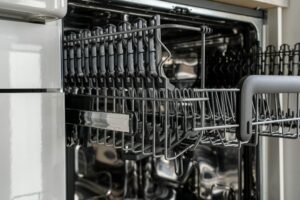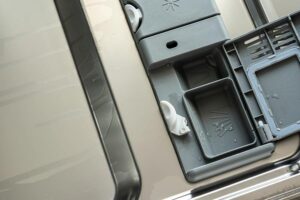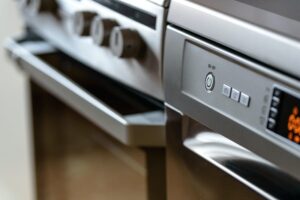Imagine that you’re sitting in your living room, enjoying a quiet evening, when suddenly you hear a perplexing sound.
It is the unmistakable gush of water filling your dishwasher when it is not supposed to be running. You may wonder: what’s going on? Why is your trusty appliance misbehaving in this way?

This article aims to delve into the baffling problem of dishwashers filling with water when not in use. This situation has left many perplexed.
We’ll explore the common causes of this issue and offer practical diagnostic steps to identify the problem. Finally, we’ll provide solutions that will help you regain control of your dishwasher. Excited? We can’t wait too!
Common Causes of a Dishwasher Filling with Water Problem and How to Resolve Them
Before we start discussing the problems, it is equally important to understand the gravity of the problem.
The truth is that when your dishwasher starts filling with water when it’s not in use, ignoring this issue can lead to water damage.
It can also lead to a higher utility bill and potential safety concerns. With that said, let’s find out the possible culprits.
Problem 1 – Troublesome Water Inlet Valve
The water inlet valve is an important component of your dishwasher. It controls the flow of water into the machine during each wash cycle.
It is like the gatekeeper of your dishwasher’s water supply, regulating the inflow. However, if this valve starts malfunctioning, it can lead to water creeping in at all the wrong times.
To tackle the problem head-on, you must recognize the red flags. Common signs of a malfunctioning water valve include inconsistent water levels, slow filling, or even no water at all.
Tackling Troublesome Water Inlet Valve
Remember, the water inlet valve is responsible for regulating water flow into your dishwasher. However, whenever it misbehaves, follow these steps to resolve it quickly
- Safety First: Before you start, ensure the dishwasher is unplugged or the power is turned off at the circuit breaker. It is an electric appliance so you need to be safety conscious.
- Locate the Valve: You will find the water inlet valve at the back of your dishwasher, often near the bottom. It is usually connected to the water supply hose. Once you locate it, go to the next step.
- Check for Leaks: Examine the valve for any signs of leaks or visible damage. If you spot any, it is a clear sign that the valve needs a replacement.
- Remove the Hose: Carefully disconnect the water supply hose from the valve. Have a towel handy to catch any residual water.
- Replace the Valve: If the valve appears damaged or isn’t working correctly, you can order a replacement part from your dishwasher’s manufacturer. Be sure to follow the manufacturer’s instructions for installation. In most cases, seeking professional help can save you lots of stress.
- Reconnect Everything: Reconnect the water supply hose once the new valve is in place. Be sure it is securely fastened.
- Power on: Turn the power back on and run a test cycle. Ensure the water level is back to normal, and you’re good to go.
Problem 2 – Worn Out or Damaged Door Seal

Your dishwasher’s door seal is often referred to as the gasket. It plays a vital role in ensuring a watertight seal when the dishwasher door is closed.
A door seal functioning properly prevents water from leaking out during the wash cycle. It also keeps water from seeping into the dishwasher when it is not in use.
However, over time, these seals can wear out or become damaged, leading to a disturbing issue. The dishwasher fills with water even when it should be idle.
Resolving Worn Out or Damaged Door Seal
Symptoms: Water accumulates at the bottom of your dishwasher between cycles or when the appliance is not in use.
Here’s what to do if you suspect that your dishwasher’s door seal is damaged or worn out:
- Visual Inspection: Start by visually inspecting the door seal. Look for any visible signs of wear, tears, or deformities in the seal. If you notice any cracks, tears, or visible damage, it is time to replace the gasket.
- Clean the Seal: Sometimes, the door seal may become dirty or obstructed, preventing it from creating a proper seal. Clean the seal gently with a damp cloth to remove any debris, residue, or food particles that may be interfering with the seal’s effectiveness. Make sure to dry it thoroughly after cleaning.
- Adjust the Door: In some cases, the door may not be closing properly due to misalignment. Ensure that the dishwasher door is properly aligned and that no obstructions are preventing it from closing completely. If it’s misaligned, adjust it carefully to ensure a snug fit when closed.
- Replace the Door Seal: If the door seal is visibly damaged or has lost its flexibility, it’s essential to replace it. Contact the dishwasher manufacturer or a trusted appliance parts supplier to obtain a compatible replacement gasket. Replacing the door seal is typically a DIY-friendly task, but if you’re unsure, consult your dishwasher’s user manual or seek professional help.

Problem 3 – Water Pressure Issues
Low water pressure may not provide enough force to fill and empty the dishwasher during its cycles. Water pressure irregularities can sometimes lead to backflow, where water flows in the opposite direction than intended.
If your plumbing system experiences intermittent backflow, it could cause water to enter the dishwasher when it’s not in use.
Troubleshooting and Resolving Water Pressure Issues
- Check Water Pressure: Verify the water pressure in your home’s plumbing system. You can do this using a pressure gauge or by consulting a professional plumber. If the pressure is too low or inconsistent, it may need adjustment or repair.
- Inspect Pressure Regulator: If your home has a pressure regulator, ensure that it’s functioning correctly. A malfunctioning regulator can lead to water pressure issues and water seepage into the dishwasher. It may need to be adjusted or replaced.
- Address Water Hammer: If you’re experiencing water hammer issues, consider installing water hammer arrestors, which are devices designed to absorb the shock and prevent pressure surges in your plumbing system.
- Consult a Plumber: If you’re unable to identify or resolve the water pressure issues on your own, it’s advisable to consult a licensed plumber. They can diagnose and address any plumbing problems that may be causing water to enter your dishwasher when it’s not in use.
By following these steps, you can troubleshoot and resolve the most common issues causing your dishwasher to fill with water when it’s not in use.
With your dishwasher back in working order, you can once again enjoy those peaceful evenings in your living room.
Wrap Up
We’ve embarked on a journey through the intricacies of dishwashers, exploring the issue of water filling when it shouldn’t.
With insight from this article, we are confident that you have become a dishwasher detective. You are now equipped with the knowledge to diagnose and resolve the issue.
We have not just discussed possible causes; we also know how to diagnose and fix these problems.
So, when your dishwasher misbehaves, don’t fret. Feel free to use your know-how to troubleshoot, repair, and maintain your dishwasher.
